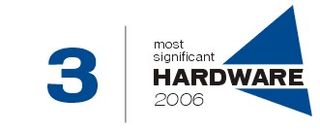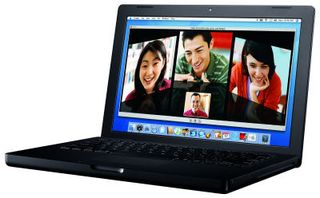TG Daily Top-10: Most significant Hardware of 2006
The Intel-Mac and the AMD-Dell (tie)

Wolfgang Gruener
What is it:
2007 Apple iMac, MacBook, MacBook Pro, MacPro, Mac mini;
Dell Dimension C521, E521, Inspiron 1501, Latitude 131L, OptiPlex 740
Why we chose it:
Let's start with Apple. There are friends who you never thought could be friends. If you are an Apple aficionado and have visited Steve Jobs keynotes in recent years, then you probably know all too well how those Power-whatever machines drove those mighty Xeon machines in the ditch and smoked one Photoshop benchmark record after another. There was lots of strange schadenfreude against Intel and unshakable enthusiasm for Apple, which you just knew would last for an eternity.
But here is 2006 and Steve Jobs and Paul Otellini are best friends. How did that happen?
You could speculate that Apple really did not have a choice in times where the Power architecture was outmuscled not only in terms of performance but especially in power efficiency and Apple was in dire need of a different supplier. We are still a bit dazzled that Apple went with Intel and not AMD, as the green team, at least from our view, would have been a better fit for the mentality of the Apple camp. But then, Steve Jobs has the kind of sales talent every company would kill for. Jobs could tell us the snow is black and we'd all believe it: In that view, the Intel proposition was really child's play.

Nevertheless, the bottom line is that Apple made one gutsy move that could have resulted in a riot in the Apple crowd. The numbers, however, prove that it was the right decision. The company sold 30% more Macs in the most recent quarter (1.61 million) than a year ago (1.24 million). Plus, the user benefit is obvious: Besides more performance, Mac users get closer to a wealth of x86 applications and Windows guys have a real chance of getting their hands on a cutting edge-style machine without having to move to an entirely new system. We patiently will wait for the final version of the Bootcamp software.
Dell-AMD
Stay on the Cutting Edge
Join the experts who read Tom's Hardware for the inside track on enthusiast PC tech news — and have for over 25 years. We'll send breaking news and in-depth reviews of CPUs, GPUs, AI, maker hardware and more straight to your inbox.
Finally! Jeez, Dell, what took you so long? It appears that everyone always knew it was a matter of time when Dell couldn't resist the pressure of consumers asking for AMD anymore. I remember asking a PR representative in 1999, if AMD wouldn't be a great move for Dell and I heard the same "we are always evaluating other technologies ..." phrase then as I did earlier this year - when an analyst floated the rumor that a Dell-AMD announcement was very likely for this year.
I discussed this topic with many tech journalists, including Charlie Demerjian from the Inquirer and we were quite certain that Dell would not go with AMD this year. A major concern was AMD's potential production capacity, which was rumored to be running around 90%+ even without Dell being a customer. Charlie was confident enough to put a bet on it against VoodooPC president Rahul Sood. I chickened out and turned Rahul's offer to join Charlie in this bet down, luckily, I have to say. As we know today, the Dell-AMD announcement came and Charlie had to do his IDF coverage in a bunny suit.
But, if you remember, even Intel appeared to have been caught on the wrong foot: In a rather memorable email to Intel employees, Intel CEO Paul Otellini expressed his disappointment over Dell's move. But in the end, Dell had little choice, but to offer AMD processors to its customers. Starting with 4P servers, it was obvious that demand for Opterons were skyrocketing and HP and Sun were grabbing market share from Dell, practically unchallenged. Moving down the ladder to the desktop and notebook came a bit late, but was a natural extension of this strategy. Rumor has it that Dell used its bold AMD announcement to negotiate new prices with Intel, but - true or not - there is little doubt that Dell has made the right decision for its customers and itself - we just wish the company would have made this move three years earlier.
What it means to you:
More choice for everyone, that's what this industry should always be about. Bridges were built this year, enabling new products strong enough to be considered part of the most significant hardware announcements in 2006.
The AMD-Dell announcement (we should not forget that Lenovo also adopted AMD) is especially significant, as it will strengthen AMD: A stronger AMD will promote healthier competition, in which AMD will be able to not only tease Intel once in a while. The result should be more innovation in the microprocessor segment than we have seen before, especially with ATI now being part of AMD.
Predictions for 2007:
Keep an eye on AMD becoming much more visible in the Dell lineup. Today, Dell is selling AMD mainly in entry-level configurations. Don't be too surprised seeing AMD's new processors, Kuma and Agena/FX, in the company's XPS series of notebooks and desktop computers. Apple is a tough one. People went bankrupt over betting on Apple products for the new year, so I will be very careful here. But I will say this: Apple will build a breakthrough entertainment PC based on Intel processors, it will roll out quad-core enthusiast Macs with more graphics capability and it will offer an UMPC-like touchscreen mobile computer, based on Intel ULV processors in 2007.
Article Coverage:
Apple announces Intel-Macs
Dell's AMD computers now available
Paul Otellini "incredibly" disappointed by Dell decision
Current page: The Intel-Mac and the AMD-Dell (tie)
Prev Page Sandisk Sansa e200 series Next Page Nintendo WiiMost Popular

